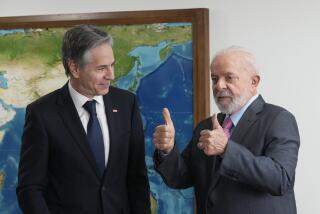Brazil May Get $30-Billion IMF Aid Package
- Share via
WASHINGTON — With the chill of global recession spreading and the world financial community clamoring for fast action, the International Monetary Fund formally embraced a new “financial architecture” Sunday while indicating that the design will take a long time to draw up.
Speaking to reporters after the IMF’s executive committee session here Sunday night, Managing Director Michel Camdessus indicated that a multibillion-dollar assistance package for Brazil is imminent since it appeared likely that President Fernando Henrique Cardoso won reelection Sunday. He is now expected to formally request international aid.
The IMF and Brazilian officials, led by Finance Minister Pedro Malan, were hashing out details of the aid package during the weekend, as financial leaders from around the world met for the joint IMF-World Bank annual meeting.
The unveiling of the package, said to total between $25 billion and $30 billion, could be announced within days, officials said. The award of the package is also contingent on Brazil’s commitment to further fiscal reforms, sources said.
“We have been working with Brazil, examining a whole spectrum of measures which could be part of a package,” Camdessus told a news conference. “But we are not there yet. We have not yet had a formal request from Brazil, and we will continue to work until this formal request is given.
“I could imagine that this could be done soon,” he said.
Camdessus also confirmed reports that the IMF and Brazil are discussing a possible acceleration of Brazil’s “crawling peg” exchange rate policy, by which the nation’s currency, the real, is allowed to devalue slowly against the dollar at a controlled rate. The real now is allowed to slide at an annualized rate of about 7%. The change would be a concession to those in the world financial community who believe the real is overvalued.
World financial officials, who are meeting through Tuesday, have converged against a somber backdrop of the worst financial crisis in a half-century. The world’s top financial officials freely admit that they did not foresee its virulence and scope, and that they are not entirely sure how to fix it.
As the global economic crisis gathered steam after Russia defaulted on its debt and devalued its currency in mid-August, U.S. and other world leaders have called for new approaches to the problem, recognizing that the response to the one now enveloping much of the world has been woefully inadequate.
The IMF said Sunday that it will begin to study possible features of the new architecture including stricter reporting methods by international lenders and borrowers, and the creation by the IMF of “public information notices” that might serve as a sort of credit rating for countries and borrowers, and act as an early-warning system for problems.
The architecture might also include emergency relief funds for countries that have been infected by the financial contagion plaguing much of the world. Funds could be used to bolster currencies under attack.
The IMF seemed to move away, however, from proposals to establish capital controls or impose limits on capital coming in and out of countries. Many officials say such controls introduce more problems than they solve.
President Clinton today is scheduled to formally present a U.S. proposal for a new IMF lending mechanism that’s aimed at aiding reform-minded countries threatened by the flight of investment capital.
As an example of the new programs being studied, U.S. Treasury Secretary Robert E. Rubin said the U.S. will support a proposal to allow the IMF to make loans to countries that have defaulted on private-sector debt.
Known as “lending into arrears,” the policy would allow the IMF to make loans if the defaulting country adopts economic reforms and makes a good-faith effort to renegotiate the debt.
The IMF currently refuses to lend to countries in arrears on debt to private creditors, who use that leverage to win favorable terms when negotiating debt restructuring.
The U.S. backing of such a plan might help restart lending to Russia, whose August default on debt and failure to meet conditions for an IMF rescue package has severed its access to outside capital.
More to Read
Sign up for Essential California
The most important California stories and recommendations in your inbox every morning.
You may occasionally receive promotional content from the Los Angeles Times.













